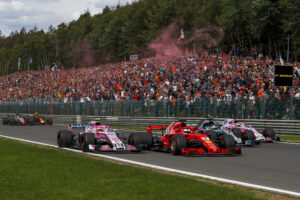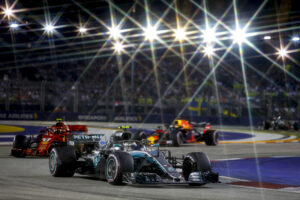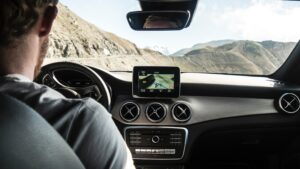As the whole world focuses on the next big thing in driverless cars, we’re looking under the bonnet at all the other innovations that deem a car ‘connected.’
 When people think of the car of the future they usually imagine something that drives (or even flies!) itself – but there’s much more to innovation in the automotive industry than just autonomy.
When people think of the car of the future they usually imagine something that drives (or even flies!) itself – but there’s much more to innovation in the automotive industry than just autonomy.
According to Gartner, there will be more than 250 million connected vehicles on the streets by the end of 2020. ‘Connected vehicle’ doesn’t just mean ‘self-driving’ – it includes anything that enhances our life on the road by communicating with other devices.
“From anti-lock brakes to rear view mirrors, motorsport has pioneered a number of things that are now considered standard on the vehicles we drive every day – and you’ll struggle to find a more connected vehicle than a modern Formula 1 car.”
Over the course of a race weekend, a Formula 1 team will farm around 2TB of data from each car. A whole web of sensors collects information on forces, temperatures, displacements and pressures, allowing the engineers and drivers to build a more complete picture of how the car is performing and helping them to slash away those elusive extra split seconds. In the all-electric Formula E series, 150 sensors monitor each car’s vital stats during testing, although only a fraction of them can be used during the race.
 While teams such as Mercedes AMG Petronas, Red Bull and Ferrari use the data collected to make their cars go around the track faster, there’s a secondary benefit that has already trickled down to road cars and they will only continue to become more sophisticated in the future.
While teams such as Mercedes AMG Petronas, Red Bull and Ferrari use the data collected to make their cars go around the track faster, there’s a secondary benefit that has already trickled down to road cars and they will only continue to become more sophisticated in the future.
Rather than telling you how to take the corners on your route to work more quickly, predictive maintenance technology uses sensors to warn car owners when a part is likely to fail.
“By monitoring the health of the battery in real time, for example, cloud-based algorithms can evaluate the chance of a breakdown and warn the driver in advance via their smartphone.”
This kind of technology relies on the transfer of data between the car and the server, which Formula 1 teams are also pioneering. The majority of what is collected can only be transferred when the car is in the pits, but as with everything in motorsports, time is of the essence. Since 2017, teams have used two wireless standards to transmit the data. It starts as soon as the car enters the pit lane, but when it’s within four metres of the garage, it switches to a faster 1.9 gigabit-per-second upload, meaning a gigabyte of data can be transferred in less than five seconds.
As more and more road cars become connected, transferring large amount of data in real-time is going to be crucial to keeping things running smoothly, particularly if human drivers are removed from the equation. The launch of 5G technology will be essential in facilitating this, with range, latency and speed all increased over what’s possible with current 4G networks.
Of course, on the road the competitive element would be removed but you’d have to consider the fact that, unlike on a racetrack, not every vehicle is travelling in the same direction. That’s where V2X comes in.
“V2X is the two-way communication between the vehicle and other devices around it that will really change how we drive.”
V2X stands for ‘vehicle-to-everything’ and is fundamental to the viability of self-driving cars, enabling each vehicle to navigate a network of streets full of traffic, pedestrians and other hazards through constant communication with almost everything it must share the road with.
 While Formula 1 can’t help in this regard, a different, emerging race series is already pushing autonomous vehicles to their limit. Roborace is in its first experimental season – ‘Season Alpha’ – of races using fully autonomous vehicles. The outer limits of the circuit layout are scanned in advance by people carrying high-precision GPS systems on scooters. Once the car knows where the asphalt ends, it’s down to the team’s algorithms to work out the quickest way around the track – without crashing into the others.
While Formula 1 can’t help in this regard, a different, emerging race series is already pushing autonomous vehicles to their limit. Roborace is in its first experimental season – ‘Season Alpha’ – of races using fully autonomous vehicles. The outer limits of the circuit layout are scanned in advance by people carrying high-precision GPS systems on scooters. Once the car knows where the asphalt ends, it’s down to the team’s algorithms to work out the quickest way around the track – without crashing into the others.
Roborace’s Devbot 2.0 cars are packed with five lidar (light detection and ranging) sensors, two radars, six cameras and 18 ultrasound sensors, which allow them to navigate racetracks at speeds of over 200mph without colliding. Even if they did, the absence of any human beings makes the track a far safer proving ground than a normal street for V2X and self-driving vehicles.
“The potential of V2X will not be limited to just autonomous driving though. It will evolve passenger’s experience as well.”
In the future, vehicles will be seen more than just a mode of transport and will offer passengers with in-car entertainment. This will be particularly true for the driverless cars where entertainment will go far beyond drivetime radio or onboard video. As autonomous cars shuttle passengers through their work commutes or on trips to places miles away, passengers—no longer tasked with driving or even navigating—will be a captive audience, complete with a steady in-car 5G connection. This newfound free time for media consumption will mean new revenue options for automotive, telecoms, advertising and content/streaming businesses, who will fight for the passengers’ attention.
With a strong focus on innovation, motorsport is testing new technology and pushing the boundaries of what’s possible. With IoT and enhanced V2X communications, these innovations will bring the new connected car experience a little bit closer.
Interested in connected cars? Read our blog about how we’re helping connect the cars in India here.
Transformational Hybrid SolutionsOur cloud-enablement services offer the best performance on your traffic-heavy websites or mission-critical applications.
Core NetworksTata Communications™ global IT infrastructure and fibre network delivers the resources you need, when and where you need them.
Network Resources
Unified Communications As A ServiceBreak the barriers of borders efficiently and increase productivity with Tata Communications’ UC&C solutions.
Global SIP ConnectEmpower your business with our SIP network and witness it grow exponentially.
InstaCC™ - Contact Centre As A ServiceCloud contact centre solutions for digital customers experience and agent productivity.
Unified Communication Resources Case studies, industry papers and other interesting content to help you explore our unified communications solution better.
IoT SolutionsThe Internet of Things is transforming the way we experience the world around us for good. Find out more about our Internet Of Things related solutions here.
Mobility SolutionsTata Communications’ mobility services enable your enterprise to maintain seamless communication across borders, with complete visibility of cost and usage.
Mobility & IoT Resources
Multi-Cloud SolutionsWith enterprises transitioning to a hybrid multi-cloud infrastructure, getting the right deployment model that yields ROI can be a daunting task.
Cloud ComplianceCompliant with data privacy standards across different countries and is also designed to protect customers’ privacy at all levels.
IZO™ Cloud Platform & ServicesIZO™ is a flexible, one-stop cloud enablement platform designed to help you navigate complexity for more agile business performance.
Managed Infrastructure ServicesIntegrated with our integrated Tier-1 network to help your business grow efficiently across borders.
Cloud PartnersWe support a global ecosystem for seamless, secure connectivity to multiple solutions through a single provider.
Cloud Resources
Governance, Risk, and ComplianceRisk and Threat management services to reduce security thefts across your business and improve overall efficiencies and costs.
Cloud SecurityBest-in-class security by our global secure web gateway helps provide visibility and control of users inside and outside the office.
Threat Management - SOCIndustry-leading threat-management service to minimise risk, with an efficient global solution against emerging security breaches and attacks.
Advanced Network SecurityManaged security services for a predictive and proactive range of solutions, driving visibility and context to prevent attacks.
Cyber Security ResourcesCase studies, industry papers and other interesting content to help you explore our securtiy solution better.
Hosted & Managed ServicesTata Communications provide new models for efficient wholesale carrier voice service management. With our managed hosting services make your voice business more efficient and better protected
Wholesale Voice Transport & Termination ServicesYour long-distance international voice traffic is in good hands. End-to-end, voice access & carrier services which includes voice transport and termination with a trusted, global partner.
Voice Access ServicesTata Communication’s provide solutions which take care of your carrier & voice services, from conferencing to call centre or business support applications.
Carrier Services Resources
CDN Acceleration ServicesOur CDN Web Site Acceleration (WSA) solution helps deliver static and dynamic content, guaranteeing higher performance for your website.
CDN SecuritySafeguard your website data and customers’ information by securing your website from hacks and other mala fide cyber activities.
Video CDNDeliver high-quality video content to your customers across platforms – website, app and OTT delivery.
CDN Resources
Elevate CXIncrease customer satisfaction while empowering your service team to deliver world-class customer experience and engagement.
Live Event ServicesTata Communications’ live event services help battle the share if eyeballs as on-demand video drives an explosion of diverse content available on tap for a global audience.
Media Cloud Infrastructure ServicesTata Communications’ media cloud infrastructure offers flexible storage & compute services to build custom media applications.
Global Media NetworkTata Communications’ global media network combines our expertise as a global tier-1 connectivity provider with our end-to-end media ecosystem.
Use CasesUse cases of Tata Communications’ Media Entertainment Services
Remote Production SolutionsMedia contribution, preparation and distribution are highly capital-intensive for producers of live TV and video content, and their workflows are complex.
Media Cloud Ecosystem SolutionsThe Tata Communications media cloud infrastructure services offer the basic building blocks for a cloud infrastructure-as-a-service.
Global Contribution & Distribution SolutionsTata Communications’ global contribution and distribution solution is built to reduce capital outlay and grow global footprint.
Satellite Alternative SolutionsAs more and more consumers choose to cut the cord & switch to internet-based entertainment options, broadcasters are faced with capital allocation decisions.
LeadershipA look into the pillars of Tata communications who carry the torch and are living embodiment of Tata’s values and ethos.
Culture & DiversityHere at Tata Communications we are committed to creating a culture of openness, curiosity and learning. We also believe in driving an extra mile to recognize new talent and cultivate skills.
OfficesA list of Tata Communications office locations worldwide.
FAQCheck out our FAQs section for more information.
SustainabilityOur holistic sustainability strategy is grounded in the pillars of People, Planet and Community with corporate governance at the heart of it.
BoardHave a look at our board of members.
ResultsFind out more about our quarterly results.
Investor PresentationsFollow our repository of investor presentations.
FilingsGet all information regarding filings of Tata communications in one place.
Investor EventsAll investor related event schedule and information at one place.
GovernanceAt Tata, we believe in following our corporate social responsibility which is why we have set up a team for corporate governance.
SharesGet a better understanding of our shares, dividends etc.
SupportGet all investor related contact information here.


